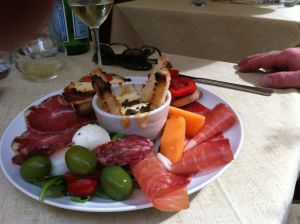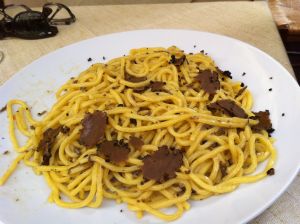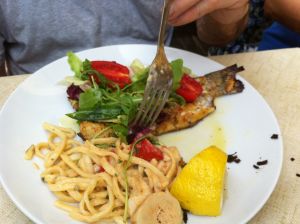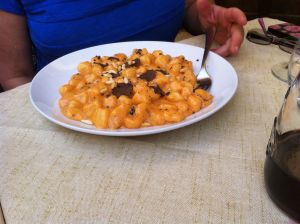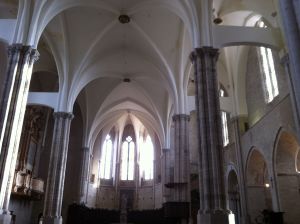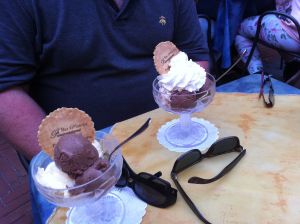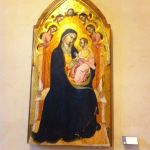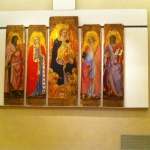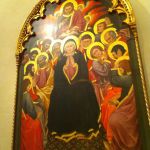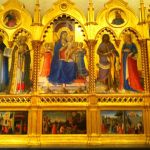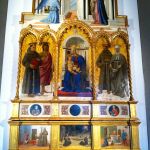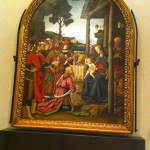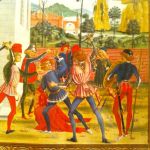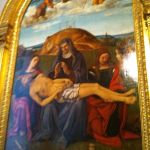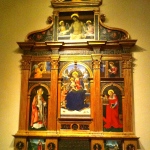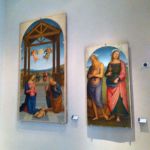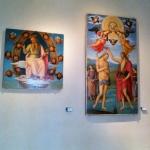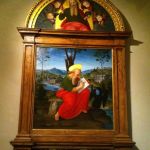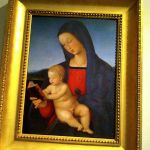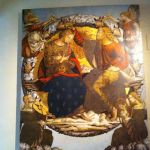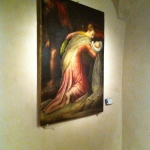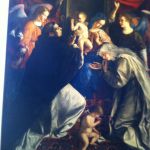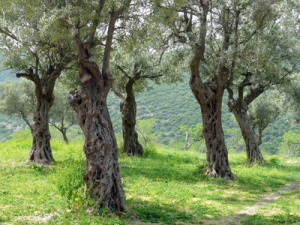This blog will take you to places you’ve always wanted to see and to some you may only have heard of. Its purpose – to immerse you in extraordinary tastes and colors, smells, sights and experiences, infecting you, or perhaps aggravating, an already serious case of wanderlust.
Many thanks for visiting Foreign Writes. Your comments are always welcome. Hope you’ll be back soon!
To view comments or to leave one, please click on the title of the post. Click on photos to enlarge.
Italy – Todi – A Perfect Umbrian Hill Town
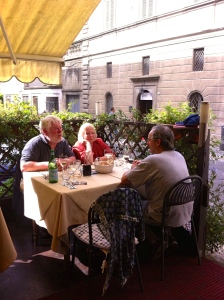 Click on photos to enlarge. One of the lures of Umbria is its hill towns – small gems, many of them fortified, whose centers have resisted modernization for a thousand years. They are the right size to fit our relaxed schedule – a late breakfast, drive of under an hour, lunch, exploration and back to La Posta di Confine in time for a swim or a nap before considering dinner.
Click on photos to enlarge. One of the lures of Umbria is its hill towns – small gems, many of them fortified, whose centers have resisted modernization for a thousand years. They are the right size to fit our relaxed schedule – a late breakfast, drive of under an hour, lunch, exploration and back to La Posta di Confine in time for a swim or a nap before considering dinner.
With traveling companions, Duke and Lisa, we have reservations in Todi at the Antica Hostaria de la Valle at 1 o’clock. We’re a little late. Finding Todi is not a problem, but finding the way into the medieval center of town through its massive walls is a little harder. Our terrace table is waiting for us. At the other nine tables, diners are well into lunch.
Mark orders the tasting menu and we all gasp at the quantity of his antipasto of cured meats and other delights which he
generously shares.
He then tackles a plate of umbracelli, a handmade local pasta akin to a very thick sphagetti, followed by a mixed grill.
Duke has a lovely whole grilled branzino (sea bass).
I order a plate of umbracelli.
All delicious. But we unanimously vote Lisa’s
gnocchi the best we have ever tasted. Topped with slivered truffles, they are pillowy heaven.
In definite need of exercise we climb the steps to the Tempio of San Fortunato. The lofty gothic interior, plain by Italian standards, is full of light – something of a relief from heavy, dark baroque.
Up the street and around a bend. There it is – the Piazza del Popolo. We catch our breaths. It is stunning. The huge piazza slopes slightly up to the cathedral that dominates its far end. Thirteenth century palazzi frame the space. Todians stroll or sit at one of its cafes much as they have done on a Sunday afternoon for hundreds of years.
We decide we’ve done enough sight seeing to justify a gelato. Down a narrow street is the Bar Pianegiani where they’ve been making it for 50 years. The setting is a small piazza filled with tables, an ancient wall fountain spilling water into a basin.
They know what they’re doing.
Italy – Perugia’s Stunning Treasure
You can see it from the tangle of autostradas at the base of its hills. Perugia – regional capital of Umbria – fought over by ancient Umbri and Etruscans, conquered by Romans, then in the center of the struggle between Popes and Emperors. Perugia – at the heart of Umbria’s post-war development, home to Perugina – famous maker of the blue and silver wrapped, chocolate/hazelnut Baci (kisses).
I was having my doubts about Perugia. My preference is for Italy’s smaller hill towns, not the Florences or Sienas – choked by chaotic traffic with impossible parking, but La Posta di Confine’s Marco directed us to the giant parking lot at the base of the fortified city, and the wonder of the mini-metro – a very cool system of small modern gondolas that pull you right into the center of the city’s medieval heart.
A short walk up a narrow street and we spill out into the Piazza Grande. In front of us, the Palazzo dei Priori – center of Umbrian government since the 13th century, and still housing city hall. It also houses something else – the Galleria Nazionale dell Umbria. I have vague expectations of some dusty local artifacts when I pay for my ticket and climb the broad stone stairway to the second floor.
 What meets my eyes stops me in my tracks. A plain wooden crucifix, stunning in its simplicity, and in its gesture of love and obedience (1236).
What meets my eyes stops me in my tracks. A plain wooden crucifix, stunning in its simplicity, and in its gesture of love and obedience (1236).
But the glitter of gold draws me to the triptych of the Madonna and Child and Stories from the Life of Christ (1270).
And then, there is the amazing painted cross (1272) breathtaking in its colors and the contrasting curve of the body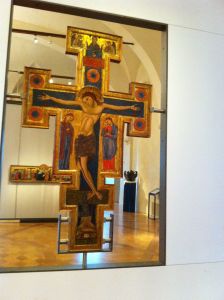 against the strict geometry of the cross.
against the strict geometry of the cross.
Wow! This room is worth the price of admission, I’m thinking, as I inspect the other glittering altarpieces and the reliefs in Carrara marble by the famous brothers Pisano, taken from the 13th century, three tier Fontana Maggiore, that anchors the Piazza Grande.
But then I move on to room 2, and it is just as glorious. And then room 3 and 4 and 5. I hardly believe what I am seeing.
In a trance, I tear myself away from each room’s treasures and move on to the next, for there are 40 rooms to see. Regional art from the 12th to the 19th centuries. There are masters whose names I recognize – Piero della Francesca, Duccio, Perugino -but there are hundreds of other glorious works by artists of equal genius.
Not knowing who else to thank for this glorious gift, I thank the woman who took my money, so grateful that we decided to buy tickets to see some ‘dusty local artifacts.’ Do click on the photos to enlarge.
Seeing great art certainly works up an appetite. The Pizzeria Mediterranea is a short walk away. Our first pizza in Italy. The pitcher of cold, slightly fizzy white wine is just right on this warm day. We order a second pitcher to go with the pizzas – from quatro formaggi to Napolitana. Perfect.
Italy – Olive Oil – Who knew?
Umbria – Olive Oil Central. Slopes covered in ancient grey-green trees. Every day at breakfast, La Posta di Confine’s Roberta serves us oil pressed from the acres surrounding our cottage. It is delicious. She tells us that pure, fresh olive oil is excellent medicine. Among its many benefits – preventing accumulation of heart disease-causing plaque. But it must be PURE – and FRESH! Most of the “made in Italy” extra virgin olive oil we consume does not come from groves like hers.
Roberta’s olives are picked, sent to the press and bottled within two or three days. She explains that once picked, olives deteriorate fast. Most of what Italy exports is made from olives picked in Spain, North Africa and Greece. By the time the oil reaches Italy and is processed, it smells bad and tastes worse. Companies then ‘clean’ the oil, refining it to remove taste and smell. What is left is basically a dead neutral substance. In order to give it some odor and taste, they add back a small amount of ‘live’ oil – but its health benefits are gone.
Small producers of pure, rapidly bottled oil are campaigning to have another standard added to labeling – one that ensures the oil contains a minimum amount of free fatty acid – the substance that promotes deterioration – a much better guarantee of freshness and purity. It’s an uphill battle. They’re up against a major Italian industry.
Alas, this summer that has ruined the Barolo grape harvest has also nearly wiped out the olives – too warm in the spring, too wet and cold during summer. Roberta won’t be pressing and bottling this year.
Master story teller, Marco, relates the story behind the name they chose for their oil. The peasant family who preceded them had a son, Dagoberto (soft a) – who was not quite right in the head. No one paid any attention to him and he was relegated to helping the women with chores around the house instead of doing “real” work in the fields with the men.
Despite his handicap, everyone knew that Dagoberto never lied.
One day the Patron came to inspect the olive harvest and Dagoberto drew him aside and told him his brothers had hidden away some sacks of olives. The Patron was well aware of his tenants’ penchant for keeping back some of the harvest, but he had had a brother much like Dagoberto, and kept a soft spot in his heart for this family. He did his best to ignore Dagoberto’s tugs on his sleeve, but the boy kept insisting, and eventually led the Patron to the hidden stash of olives.
olives.
Marco and Roberto decided that Dago’s legendary honesty set the right standard for the oil they produce, and now his name adorns bottles that travel well beyond Italy.
Roberta’s tips: The fresher the better – try to enjoy olive oil within a year of bottling. Keep it in the dark and keep it cool. And a tablespoon a day of the real thing is great medicine. Who would want to ignore that advice?
Next: Perugia’s Treasure
Italy – If you go to Umbria . . .La Posta di Confine
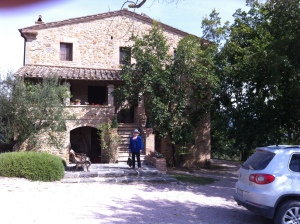 As always, click on photos to enlarge. A four-hour drive to Florence to pick up our friends and then a couple of hours to Mantignana and our
As always, click on photos to enlarge. A four-hour drive to Florence to pick up our friends and then a couple of hours to Mantignana and our 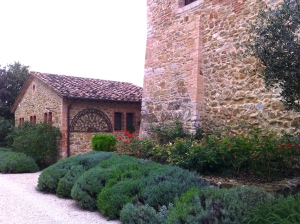 agriturismo, La Posta di Confine (www.lapostadiconfine.it). We find Via Alta, but the white monster is no match for the steep, winding, one-lane gravel road. About halfway up, the wheels start to spin. White knuckles. Mark backs down a bit and we inch forward. The smell coming from under the hood is not pleasant. With great joy we arrive at the wrought iron gates of La Posta di Confine and announce ourselves. The gates open and we drive into everyone’s dream of Italy, greeted by our hostess, Roberta Biagioni Angeli, and an angel she is.
agriturismo, La Posta di Confine (www.lapostadiconfine.it). We find Via Alta, but the white monster is no match for the steep, winding, one-lane gravel road. About halfway up, the wheels start to spin. White knuckles. Mark backs down a bit and we inch forward. The smell coming from under the hood is not pleasant. With great joy we arrive at the wrought iron gates of La Posta di Confine and announce ourselves. The gates open and we drive into everyone’s dream of Italy, greeted by our hostess, Roberta Biagioni Angeli, and an angel she is.
La Posta Di Confine started life in the 1500s as a tower, a guard post between two castles. It evolved into a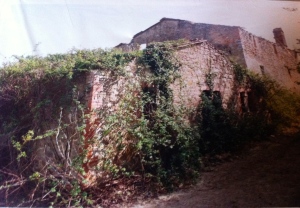 residence for tenant farmers attached to a large agricultural estate. Abandoned as a residence in the early 1960s, Marco and Roberta found it in ruins in 1993. But they had a vision. Over the next 15 years they brought it back to life. It certainly helped that Marco does this sort of work for a living. They began receiving guests in 2008.
residence for tenant farmers attached to a large agricultural estate. Abandoned as a residence in the early 1960s, Marco and Roberta found it in ruins in 1993. But they had a vision. Over the next 15 years they brought it back to life. It certainly helped that Marco does this sort of work for a living. They began receiving guests in 2008.
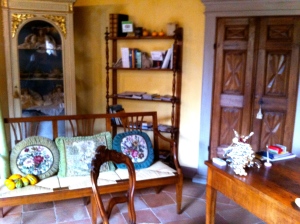 It is a magical place, filled with furnishings, most antique, that complement the perfect colors Roberta has chosen. Our apartment’s kitchen/dining/sitting room is part bare stone walls and part freshly plastered walls painted in coral and a pale green. Its modern appliances provide everything we need to cook for ourselves, should we wish to. The giant marble sink even makes washing up a pleasure.
It is a magical place, filled with furnishings, most antique, that complement the perfect colors Roberta has chosen. Our apartment’s kitchen/dining/sitting room is part bare stone walls and part freshly plastered walls painted in coral and a pale green. Its modern appliances provide everything we need to cook for ourselves, should we wish to. The giant marble sink even makes washing up a pleasure.
Our pale yellow bedroom features a bed with portraits of two lovely young things on the headboard. Marco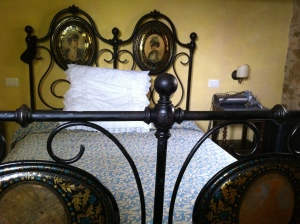 explains that the bed came from a bordello.
explains that the bed came from a bordello.
And then there is the salt water pool and its terrace, our first stop after unpacking the car. The view down the olive tree covered hill and over the valley is stunning
 . . . . and the pool’s water washes away the fatigue of the day’s long journey.
. . . . and the pool’s water washes away the fatigue of the day’s long journey.
At breakfast we sample local specialties — cheeses, prosciutto, truffles, yogurt, locally roasted coffee,  Roberta’s home-made jams and breads, her wonderful organic olive oil, and each morning a different freshly baked pastry.
Roberta’s home-made jams and breads, her wonderful organic olive oil, and each morning a different freshly baked pastry.
In one of our email exchanges, I told Roberta we would be traveling with concert pianist Lisa Lanza. The week before our arrival, Marco had their antique German piano tuned for her. One evening, after dinner, Lisa played a mini-concert for Roberta, Marco, their son Francesco, and the other guests. Magic. Post-concert, we dipped Roberta’s freshly baked biscotti in local Vin Santo while Marco recounted the history of the property and I translated.
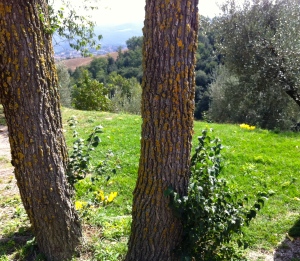 The 20 members of the last family to live in the house slept in two small rooms. The father had married twice, producing four sons from each wife. Conditions for them, even into the 1960s, were feudal. The owner of the estate controlled their lives down to decisions as to which sons were allowed to marry. They were extremely poor — no electricity, a tiny flow of water from a hand-dug well. They eked out a living from olive trees and a patch of grain. At one point, according to stories told Marco by local residents, the father went to the estate owner to beg for help as they had so little to eat, and was told he had brought his misery on himself by having too many children. The farmer replied that the Patron could go to the movies, his only entertainment was with his wife.
The 20 members of the last family to live in the house slept in two small rooms. The father had married twice, producing four sons from each wife. Conditions for them, even into the 1960s, were feudal. The owner of the estate controlled their lives down to decisions as to which sons were allowed to marry. They were extremely poor — no electricity, a tiny flow of water from a hand-dug well. They eked out a living from olive trees and a patch of grain. At one point, according to stories told Marco by local residents, the father went to the estate owner to beg for help as they had so little to eat, and was told he had brought his misery on himself by having too many children. The farmer replied that the Patron could go to the movies, his only entertainment was with his wife.
There were no heirs to the estate on the death of this owner, and the property was taken over by an agricultural cooperative. The peasant family dispersed, drawn to a better life working in the factories of  industrializing Umbria.
industrializing Umbria.
Should you ever go to Umbria, you would be SO fortunate to be a guest at La Posta di Confine!
P.S. The next day we exchange the white monster for a Fiat 500L and our hill problem is solved.
Italy – At Home in Barolo
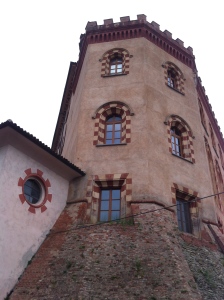 There have been fortifications here since the tenth century. The present castello has its origins in the 13th century. It belonged, of course, to the Falleti family,who seem to have owned everything in the area. They had another castello a few hundred yards up the hill – Castello della Volta – now in ruins. The Commune of Barolo has put the former riding school
There have been fortifications here since the tenth century. The present castello has its origins in the 13th century. It belonged, of course, to the Falleti family,who seem to have owned everything in the area. They had another castello a few hundred yards up the hill – Castello della Volta – now in ruins. The Commune of Barolo has put the former riding school  attached to the castle to good use. It is a beautiful regional showcase for Barolo, with 32 wines for tasting.
attached to the castle to good use. It is a beautiful regional showcase for Barolo, with 32 wines for tasting.
What we learned about Barollo – Piemonte’s (and perhaps Italy’s) premier wine: It is made from Nebbiolo grapes grown only on south-facing slopes on 2,000 hectares of land around Barolo. Wine from slopes with other orientations is bottled as Nebbiolo. Barolo is sold in its fourth year. Grapes grown on the area’s sandier soil produce a lighter, fruitier wine that may be drunk at four years, but is best kept longer and will last about 8 years. Grapes grown on the area’s clay soil produce a more acidic, complex wine that shouldn’t be drunk before its 8th year. It continues to improve and can be held about 20 years. To produce the best wine, springs must be rainy, summers hot and dry and falls warm with cool nights – not the conditions in 2014. With a cool, rainy summer, the next two weeks will be crucial to ripening the grapes. Without enough warm days, there may not be much Barolo bottled this year. Instead it will be bottled and sold as Langhe di Nebbiolo, a less prestigious drink.
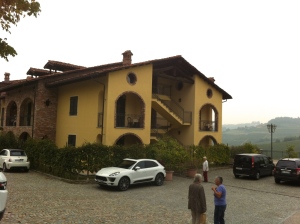 Hotel Barolo has been our home for a week. Its Ristorante Brezza serves good food, breakfasts are more than we should eat, and the location is perfect for exploring this stunning countryside. We will miss our
Hotel Barolo has been our home for a week. Its Ristorante Brezza serves good food, breakfasts are more than we should eat, and the location is perfect for exploring this stunning countryside. We will miss our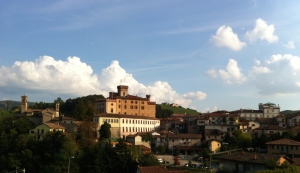 view over the village and the castello.
view over the village and the castello.
Next stop – Umbria!


